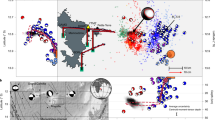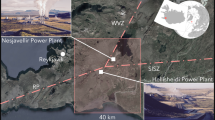Abstract
SINCE March 1957, a seismological station has been in operation at Scott Base (77° 51′ S., 166° 48′ E.) on Ross Island. The seismometers, three Benioff-type instruments, feed three short-period (0.2 sec.) galvanometers and three longer-period galvanometers (vertical and east–west 25 sec.; north–south 10 sec.). The installation was not explicitly designed for microseismic recording, the main objective being the determination of local seismicity. However, following some interesting qualitative observations at the Base, a preliminary examination of microseismic amplitudes and periods has been made.
This is a preview of subscription content, access via your institution
Access options
Subscribe to this journal
Receive 51 print issues and online access
$199.00 per year
only $3.90 per issue
Buy this article
- Purchase on Springer Link
- Instant access to full article PDF
Prices may be subject to local taxes which are calculated during checkout
Similar content being viewed by others
References
Donn, W. L., Science, 119, 56 (1954).
Donn, W. L., Trans. Amer. Geophys. Union, 38, 358 (1957).
Author information
Authors and Affiliations
Rights and permissions
About this article
Cite this article
HATHERTON, T., ORR, R. Microseisms at Scott Base. Nature 183, 1760–1761 (1959). https://doi.org/10.1038/1831760a0
Issue Date:
DOI: https://doi.org/10.1038/1831760a0
Comments
By submitting a comment you agree to abide by our Terms and Community Guidelines. If you find something abusive or that does not comply with our terms or guidelines please flag it as inappropriate.



